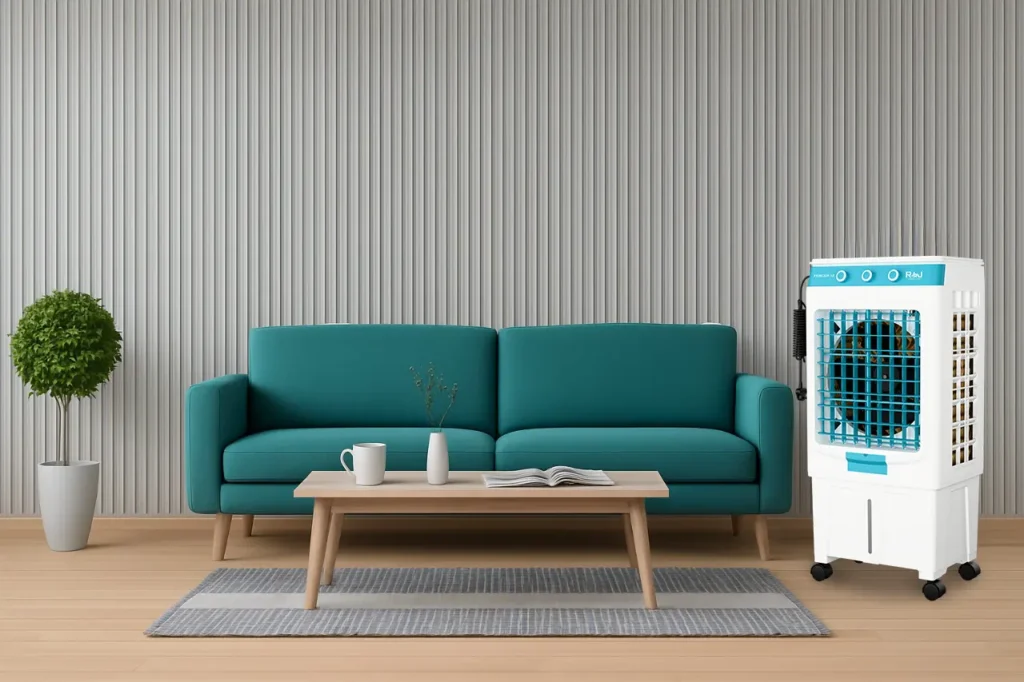Air coolers are one of the most cost-effective and eco-friendly cooling solutions, especially in areas with dry and hot weather. They use far less electricity than air conditioners and circulate fresh, naturally cooled air. However, using an air cooler in a closed room needs special care. If not handled properly, the room can quickly become humid and uncomfortable, and the cooler may lose its efficiency.
This guide will help you understand the challenges of using an air cooler in a closed room and provide smart tips to get the best cooling performance while keeping your environment fresh and comfortable.
Challenges of Using Air Coolers in Closed Rooms
When you use an air cooler in a closed room, one of the biggest challenges is humidity buildup. Since coolers work by evaporating water, the moisture released into the air has nowhere to escape in a fully sealed room, leaving the space feeling sticky and damp. This not only creates discomfort but also makes it difficult for the cooler to lower the room temperature effectively. Another issue is reduced airflow. Air coolers depend on a constant exchange of warm and cool air to work efficiently. In a closed environment, the cooler ends up recycling the same warm air, which decreases its cooling capacity.
Additionally, stagnant air in a sealed room can cause it to feel stuffy and unpleasant, which can lead to breathing problems, especially for people with allergies or respiratory issues. If the cooler is not maintained properly, the standing water and wet pads may also produce unpleasant odors or even encourage mold and bacteria growth. These problems highlight why using an air cooler in a closed room requires a few smart strategies to avoid discomfort and inefficiency.
Smart Tips to Use Air Coolers Efficiently
Ensure Proper Ventilation
Even though it might seem counterintuitive, some form of ventilation is essential when running an air cooler in a closed room. Keeping a small window or door slightly open allows warm, humid air to escape and lets fresh air enter the room. If the space has an exhaust fan, it can be used to push out stale, damp air more effectively. Placing the cooler near a window or opening also ensures it draws in dry, fresh air from outside, which is crucial for proper cooling. Without ventilation, the cooler will only circulate damp, warm air, which reduces comfort and performance.
Maintain Water Levels and Pads
Water plays a vital role in the cooling process, and maintaining the right water level ensures your cooler performs at its best. Always fill the water tank before switching on the cooler, and make sure to use clean water to prevent odors and mineral deposits. The cooling pads should also be kept in good condition, as they are responsible for absorbing water and facilitating the evaporation process. If the pads are dirty, worn out, or dry, the cooler’s efficiency will drop significantly. Regularly checking and replacing pads helps maintain consistent cooling and prevents unpleasant smells.
Position the Cooler Correctly
The position of the air cooler can greatly influence how well it cools a room. Placing the cooler near a window or a source of fresh air ensures a steady supply of dry air for the cooling process. It’s also a good idea to keep the cooler slightly elevated by placing it on a stand or table so that cool air spreads evenly throughout the room instead of staying close to the floor. Avoid placing the cooler directly in a corner or blocking its front, as this can restrict airflow and prevent effective cooling.
Use Ice or Cooling Enhancers
If you want to take the cooling effect up a notch, adding ice or cooling enhancers can be a quick solution. Many modern coolers come with a dedicated ice chamber where you can add ice cubes or frozen water bottles to lower the air temperature more quickly. This is especially useful during extremely hot days. However, it’s important not to add too much ice at once, as this can slow down the evaporation process and reduce the cooler’s overall performance. Moderation is key when using ice to boost cooling.
Regular Cleaning for Better Performanc
Routine cleaning and maintenance are essential for ensuring that your air cooler works efficiently and lasts longer. The water tank should be cleaned at least once a week to prevent the growth of algae or bacteria. The cooler’s outer body and grills should also be wiped down to remove dust buildup, which can affect airflow. In addition, the pump and pipes should be flushed every month to keep the water circulation smooth. Regularly replacing or deep-cleaning the cooling pads will prevent mold, odor, and blockages, ensuring fresh and hygienic air.
Common Mistakes to Avoid
A common mistake people make is keeping the room completely sealed while the cooler is running. This traps humidity and drastically reduces cooling performance. Using dirty water or neglecting to replace worn-out pads can also lead to unpleasant odors and poor hygiene. Placing the cooler in a corner or blocking its airflow prevents it from cooling the room effectively. Another mistake is adding excessive amounts of ice, which can disrupt the cooling process rather than improve it. Finally, ignoring regular maintenance can lead to decreased efficiency and costly repairs over time. Avoiding these pitfalls will help you get the most out of your cooler.
Conclusion
Using an air cooler in a closed room can be challenging, but with the right practices, you can enjoy efficient and comfortable cooling. Proper ventilation, consistent water and pad maintenance, correct placement, and routine cleaning all play vital roles in ensuring top performance. By avoiding common mistakes, you’ll not only improve cooling efficiency but also extend the life of your cooler and reduce energy costs. With these smart tips, you can create a cool and refreshing environment even in the hottest months.

